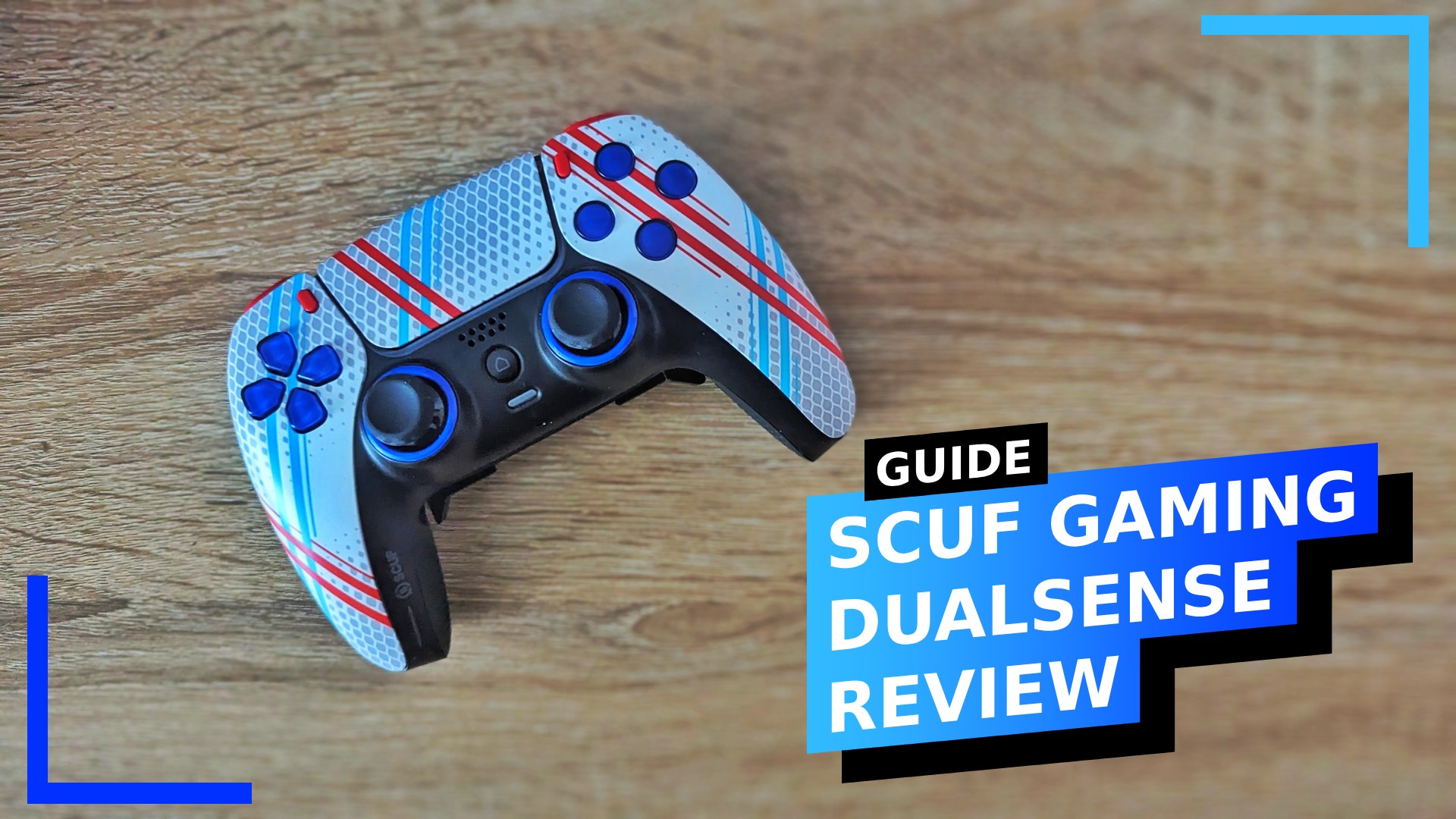How does the Scuf Gaming PS5 controller stack up in a market with multiple premium offerings? Is it better than the Dualsense Edge? Find out as I go hands-on with this must-have controller.
How It Feels.
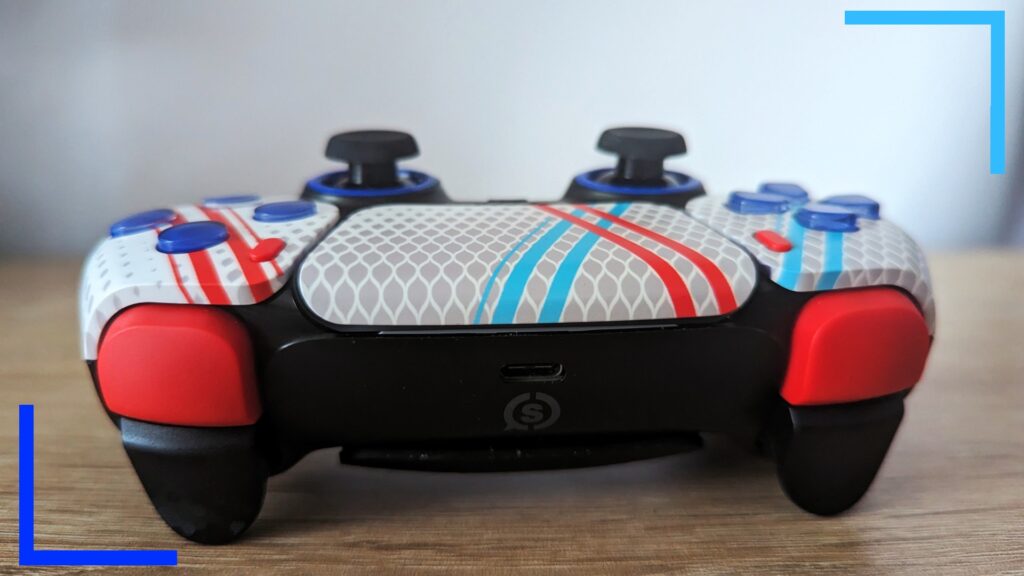
I went with the Scuf Gaming PS5 Reflex Pro controller for this review and the upgrades to the Dualsense make it the most comfortable controller out there.
When it comes to textures, the replacement parts – in my case a new shell and buttons – feel very similar to the original PS5 Dualsense controller, albeit slightly less glossy. It’s a minor change, but the end result is the main shell feels less slippery to the touch. This isn’t something you’d ever notice until you’ve got an original PS5 controller and the Scuf Reflex Pro next to one another, but it’s there.
Included with the Pro is the introduction of rubber grips around the handles (where the vibration motors are housed). As someone who plays games for a living, my hands will get sweaty. That’s just how it is. When I’m reviewing Baldur’s Gate 3, which needed me to sink 40 hours into before I had an idea of what’s what, the rubber grips really helped to stop the controller from feeling overly warm, and reduced the need to wipe my hands on my shorts.
I’ll admit the rubber grips won’t be for everyone. I let my eldest play with the controller and they weren’t a fan. For me, though, they’re a smart addition. Although I prefer the Dualsense over the Xbox controller, I’m a fan of the Xbox’s textured grips, and the rubber equivalents found in the Scuf PS5 controller are a further improvement on that setup.
What’s interesting is the face buttons on the Scuf Reflex Pro are slightly more shallow than the original buttons. They’re flatter and less convex. Another small change, for sure, but it helps to reduce travel time between the button itself and the area of the motherboard the button makes contact with.
With the back triggers, of which there are now four, I fully expend to pull the P2 and P3 (the inner two triggers) out in favor of using just the two. The reason being: When you look at a picture of the controller, the four back buttons look cramped, but the first time I held it, I realized all four buttons have been designed to feel natural and intuitive to where your middle fingers land.
I ended up sticking with and using all four. One of the problems with modern controllers is the bumpers require overstretching of index fingers. With the Reflex Pro, I could remap those buttons to the paddles and use the inner panels for the face buttons I needed (normally reload).
It is a shame you can’t remap the triggers to the back paddles, but Scuf is working within a shell designed by a company that didn’t plan for another company to come along and gut their controllers to make them better. So, a shame it is, but it’s understandable.
Also as a very niche side note, if you play Overwatch and often find yourself Mercy jumping a lot, you absolutely need this controller. It makes the act of split-second inputs all the more fluid.
Features.
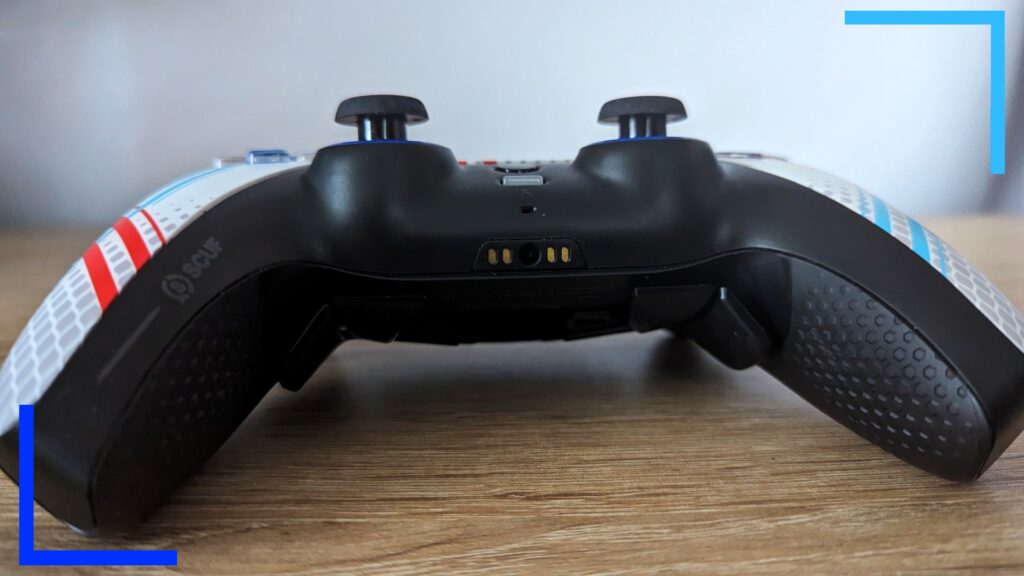
Let’s dig into what exactly the Scuf Gaming PS5 controller is and isn’t. It’s not a third-party controller in the way that an 8BitDo or Logitech controller might be. Instead, it’s an official Sony PS5 Dualsense controller that’s been ripped apart and individually modified to improve it.
In the Reflex Pro’s case, it’s a Dualsense with four added remappable back paddles, custom sticks that can be replaced with different sizes, and a host of customization options like designer faceplates or different colored buttons and rims.
For this review, I went with the summer range faceplate (the white with red and blue motifs), but you’re free to change up the colors and design when you’re virtually building the controller on the Scuf Gaming website.
One of the coolest things is how you can remap different buttons to the removable back paddles. You can’t map the triggers, home, create, or options to them, but everything else is fair game. That means swapping weapons in Fortnite or reloading in a first-person shooter can be performed with your middle fingers rather than needing to remove a thumb off the camera stick.
You don’t realize just how much of a difference to gameplay it makes until you’ve got a better option in hand. I felt the same when gaming on the Steam Deck, which also has back paddles. That one second where you move your thumb can really make the difference. If someone shoots at you and your thumb isn’t on the stick, you’re screwed. But with the Reflex Pro, your thumb almost never needs to leave the sticks or triggers. The needed buttons are at your fingertips almost always.
Plus it feels much more intuitive to press a button with a middle finger than a thumb. Again, it’s something you don’t realize until you have a better option presented.
You can also set up your own back paddle profiles to tweak things to your liking. Above the four paddles is a small button. Tap it to change profiles, or hold it down and tap the buttons you want to map and it’ll save the profile to the on-board chip. That means you can switch between a racing, RPG, first-person, or whatever profile you design on the fly.
It’s another small touch, but it’s all these small touches that make the Scuf Gaming PS5 controller such a joy to use. They add up, and the end result is a controller that refines what Sony built and improves it tenfold.
Scuf Reflex Pro vs Dualsense Edge.
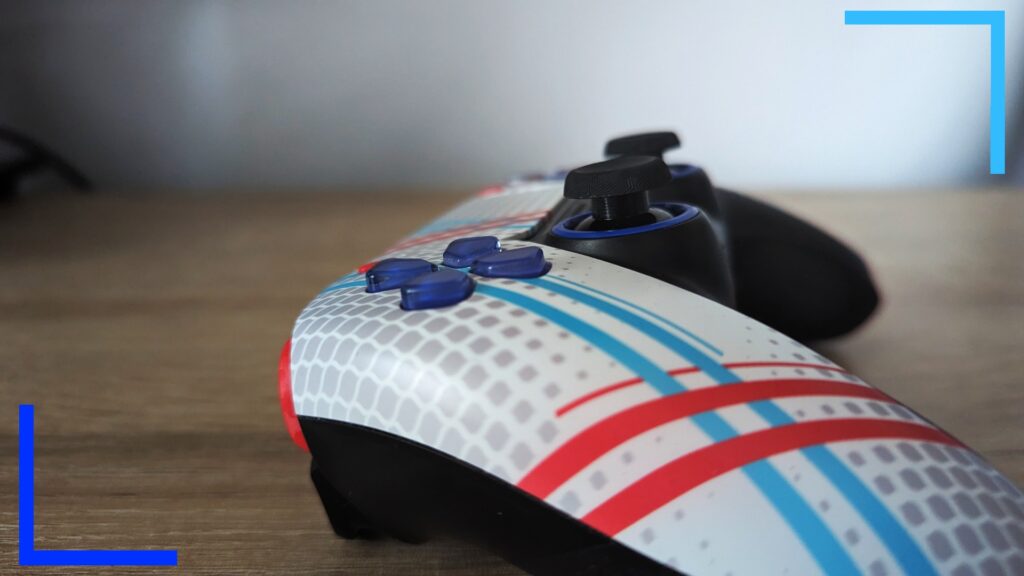
I reviewed a Dualsense Edge controller recently, and while it’s great, it’s almost a downgrade when compared to what Scuff Gaming is offering.
For a start, the Dualsense Edge only has two back paddles. The Scuf Reflex Pro has four. I’d also argue the Scuf setup is much more comfortable and natural feeling. The Dualsense Edge’s paddles aren’t bad by any means, but Scuf has the experience here. Scuf has been refining its paddle tech for years, so I’d always expect Scuf to beat Sony outright.
The other factor – and this is very important to me – is battery life. With the Scuf PS5 controller I was pulling Dualsense levels of battery life (seven to eight hours). With the Dualsense Edge, I’d need to recharge after around four to five hours, which is pitiful for a controller that expensive.
While the overall shape of the Dualsense Edge feels nicer, everything else is bested by the Scuf Gaming Dualsense. Battery, remap functions, extra paddles – it’s Scuf Gaming that has the edge.
Price Info.
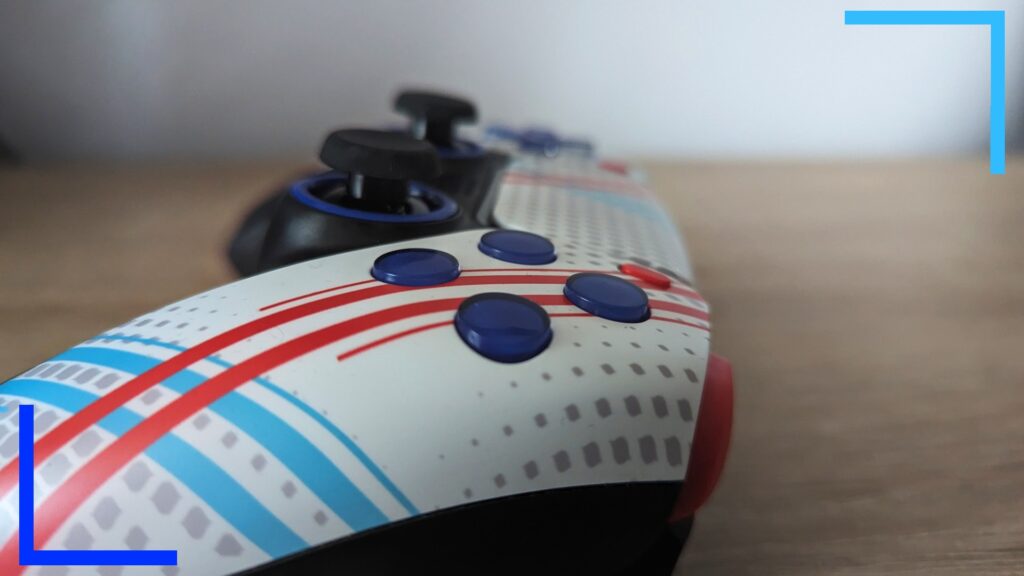
The most basic Scuf PS5 controller starts from $209.99/£229.98. To compare, the Dualsense Edge is $199.99/£209.99. So that’s about an extra $10/£20 for a controller with two extra paddles and a better battery. That’s worth it if you ask me.
Of course, if you want to customize the controller, that’s where the price goes up. Extra colors, designs, rim trims, and that snazzy rubber Reflex Pro grip will up the price. It’s still all your choice, though. You don’t have to pay for any extras if you don’t feel like you’ll make use of them.
Verdict.
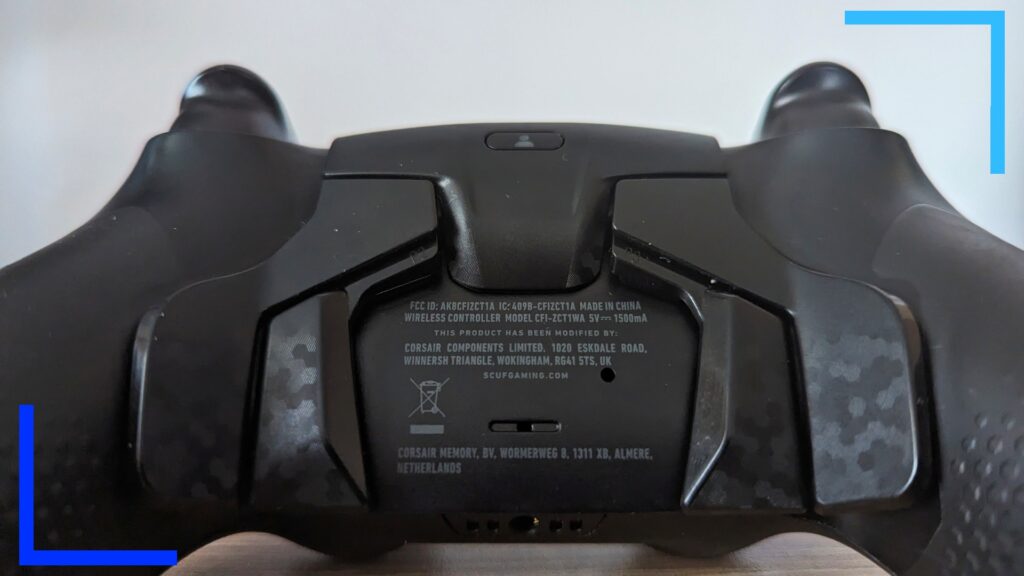
Faster travel time, solid battery life, smart button placement, and being able to switch profiles on the fly all help to make the Scuf Gaming PS5 controller the best controller available.
It is pricey, but when you’ve got a team building individual controllers rather than mass-producing, and the end result is something as sumptuous and sleek as the Reflex Pro, it’s one of the few occasions where the cost is justified and understood.
If you’re a PS5 or PC player and want the most comfortable controller on the market today, I’ve got no problem recommending the Scuf Reflex Pro.
All photos captured by RetroResolve. | Review unit provided by Scuf. | To learn more about our review policy click here. | Alternatively, click here to find out why you can trust me.
| How I Tested. | |
| Time Tested: | Over 100 hours across the space of two weeks. |
| Tested on: | PS5, ASUS ROG Ally, and Steam Deck. |
| Games Tested On: | Skyrim, Baldur’s Gate 3, Cyberpunk 2077, Elden Ring, Peggle, Fortnite, Apex Legends. |
| Resistance: | Dropped five times from a height of 20 inches with no cosmetic damage incurred. |
| Drift Status: | Doesn’t use Hall effect sticks, but no drift was detected during the review period. |
| DS4Windows Compatibility: | Works perfectly with zero issues. |

